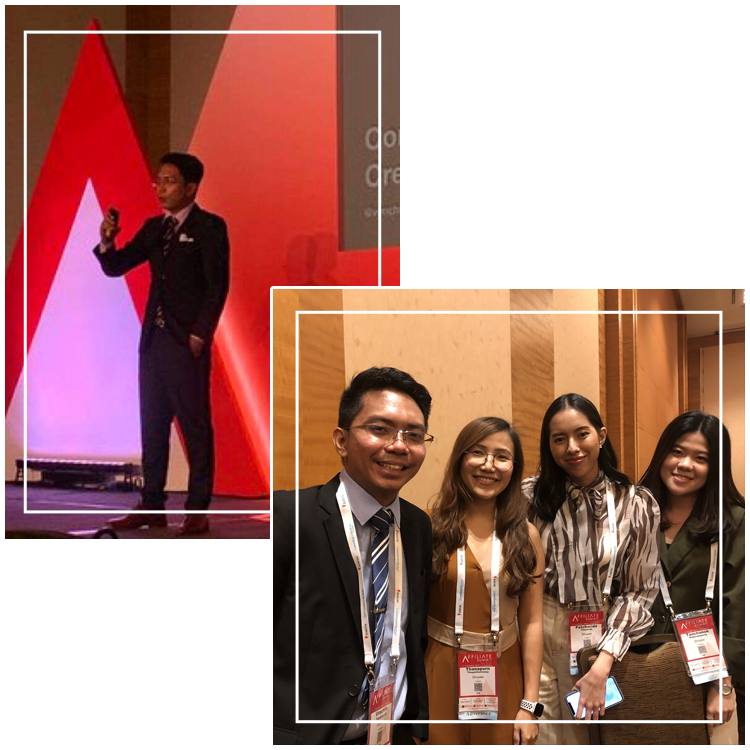A keynote speaker makes powerful highlights.
Persuasive. Powerful. Presenter.
Keynote speaking in the Philippines summarizes the core message or the central underlying theme of the entire event.
You need a keynote speaker who can customize a speech to bring the atmosphere that you want for your audience during those seminar hours they’re in.
It is all about setting the right tone, mindset, and expectations – either what kind of information they will hear from other speakers, why is the event conducted in the first place, and what they should expect during and after the program.
Effective Keynote Speaker in the Philippines
Persuasive, Powerful, and Presenter
What does a good keynote speaking engagement look like in real life?
Inspiring Speech
The best keynote speaker in the Philippines that you should be looking for is inspirational or motivational. You need a keynote speaker who has a unique ability to inspire his audience with stories and powerful illustrations. With a limited period for a keynote speech, the presenter must get power up the audience at the beginning.
Unify The Audience
You want a keynote speaker who can unify his audience with a 30 minute to 45-minute speech. Not too long, not too short — just enough to help the audience identify the primary purpose and objective of the event. It unifies the audience with fundamental truths, whether it's a sales rally event, an opening night for a conference, or a charity event for a non-profit organization.
Direct to Purpose and Goals
Many keynote speakers in the Philippines can present their slides to their audience. Some would just do a little of Google research. But few good keynote speakers how to direct people to the purpose and goals of the event. He chooses powerful and persuasive words to help the audience understand what the main event is all about.
Start With Theme and Build Momentum
The first speech of conferences, seminars, or any type of event is crucial to set the theme. When it is done right, the audience would feel a sense of learning and be more attuned to hearing other speakers during the event. A good keynote speaker sets the tone and builds the momentum for every other event activity.
A glimpse of what Venchito does on a day-to-day basis (aside from being a keynote speaker).
As an Entrepreneur
At the age of 21, he started his own company, SharpRocket, one of the fastest-growing digital marketing companies specializing in search engine optimization services. He is currently the Marketing Director who has helped hundreds of brands and agencies worldwide generate better quality leads for their businesses.


As a Global Speaker
Venchito spoke at global conferences. He represented the Philippines in the recent Affiliate Summit Asia Pacific in Singapore. It is a global conference with 40 countries represented, including Malaysia, Singapore, Indonesia, India, China & Thailand. With over 600 attendees from famous brands such as Airbnb, Microsoft, Zalora, Shopee, Booking.com, and Klook.
As an Author
In 2016, he published Career Crossover, a book on career management for youth and young professionals helping them navigate their careers towards their giftings, strengths, and mission in life.
As a Certified Facilitator
Venchito Tampon is one of the certified practitioners of the Emotional Intelligence program by GENOS International, which trains global companies like Walmart, Amazon, Microsoft, and IBM. A Certified Facilitator of YOUNIque DISC: Understanding Others by Understanding You, a personality development program created by Mr. Jayson Lo, has brought change to top 1000 corporations, including San Miguel Corporation and Puregold.
As a Marketing Consultant
Digital agencies, eCommerce business owners, and enterprise marketing executives in the US, Canada, and Australia consult Venchito for lead generation and marketing needs.
As a Mentor
With over 80,000 followers across social media platforms, Venchito shares inspiration and actionable tips for Filipinos about productivity, personal growth, and professional life.
Hire a keynote speaker other people are learning from.
Whether at local media outlets or writing for leading international publications, the industry respects this speaker for his know-how.
But don't worry: we save the best stuff for your participants.
Kind words from people who speak better than I do.
You may also want to consider them as your speakers.
Jayson Lo
Author of Younique | Corporate Trainer
“Venchito is a next-gen entrepreneur and speaker who proves that millennials have the highest potential to change our country. His talks motivate young people to be more focused and purposeful to reach their maximum potential. And just like him, to turn their life around from a zero to a hero.”
A keynote speaker is a speaker who is invited to give a speech at a conference or event that sets the theme or tone for the event.
The keynote speech is usually the opening or closing speech of the event, and is meant to be inspiring, informative, or thought-provoking.
Keynote speakers are often thought leaders or experts in their fields, and are chosen for their ability to engage and inspire the audience.
Venchito is one of the Filipino motivational speakers who can do keynote speeches.
A good keynote speech should be well-organized and structured, with a clear introduction, main points, and conclusion.
It should also be tailored to the audience and the purpose of the event. Some things you may want to include in your keynote speech are:
An engaging opening: Start with a compelling story, a question, or a quote to grab the audience’s attention.
A clear structure: Divide your speech into clear sections or themes, and use signposts to help the audience follow along.
Personal anecdotes: Personal stories can be a powerful way to illustrate your points and connect with the audience.
Statistics and examples: Use data and examples to support your main points and make them more credible.
A call to action: End your speech with a clear call to action or next steps for the audience to take.
Overall, it’s important to be authentic and speak from the heart, and to use your knowledge and expertise to deliver a message that is informative, inspiring, and relevant to the audience.
The length of a keynote speech can vary depending on the event and the time allocated for the speech. Typically, a keynote speech is anywhere from 20 to 60 minutes long.
However, it’s important to consider the needs and attention span of the audience, as well as the purpose of the speech.
A shorter, more concise speech may be more effective in some cases, while a longer speech may be needed to cover a complex topic in greater depth.
It’s also a good idea to practice your speech and time it to ensure that it fits within the allotted time.
To prepare for a keynote speech, you will want to do the following:
- Research your audience: Find out as much as you can about the people who will be attending the event, including their demographics, interests, and expectations.
- Define your message: Determine the main points you want to make in your speech, and think about how you can best deliver that message to your audience.
- Outline your speech: Organize your ideas and create an outline for your speech.
- Practice, practice, practice: Rehearse your speech out loud, and get feedback from others to help you refine it.
After your keynote speech, you may be asked to take questions from the audience. Here are some tips for handling Q&A:
- Stay calm and composed: It’s natural to feel nervous when answering questions, but try to stay calm and composed. Take a few deep breaths, and remind yourself that you are an expert in your field and have prepared for this moment.
- Listen carefully: Pay attention to the question being asked, and make sure you understand it before answering. If you didn’t catch everything, it’s okay to ask the person to repeat or clarify the question.
- Answer honestly: If you don’t know the answer to a question, it’s okay to say so. You can also offer to follow up with the person after the event to provide more information.
- Be respectful: Treat the questioner with respect, even if you disagree with their perspective. Avoid getting defensive or confrontational, and try to find common ground.
- Keep it brief: While it’s important to be thorough and informative in your answers, try to keep your responses concise. This will allow you to address as many questions as possible in the allotted time.
It’s important to dress appropriately for your keynote speech, as your appearance can impact your credibility and the way you are perceived by the audience.
Here are a few tips:
- Consider the audience and the event: Think about the demographics and expectations of the audience, as well as the formality of the event. For example, you may want to wear a suit for a corporate conference, but a more casual outfit for a tech meetup.
- Choose comfortable, professional attire: Wear clothes that are comfortable and that you feel confident in. Avoid anything too tight, loose, or revealing.
- Accessorize appropriately: Choose accessories that complement your outfit and add to your professional image. Avoid overloading on jewelry or other distractions.
It’s normal to feel nervous before a keynote speech, but stage fright can be debilitating if not managed properly.
Here are a few tips for dealing with stage fright:
- Prepare thoroughly: The more prepared you are, the more confident you will feel. Research your audience, practice your speech, and plan for any possible contingencies.
- Use positive visualization: Close your eyes and visualize yourself giving a successful speech. Imagine the audience responding positively to your message, and see yourself handling any challenges with ease.
- Use relaxation techniques: Take a few deep breaths, stretch, or use other relaxation techniques to calm your nerves before you go on stage.
- Focus on the audience: Instead of worrying about yourself, focus on the audience and your message. Remember that you are there to share your knowledge and expertise with them.
It’s possible that you may encounter a difficult audience member during your keynote speech. Here are a few tips for handling such situations:
- Stay calm and composed: It’s important to maintain your composure, even if the audience member is confrontational or disruptive.
- Address the issue: If the audience member is disrupting the event, politely ask them to stop or ask the event organizer to intervene. If the issue is related to your speech, address it directly and try to find common ground.
- Use humor: If appropriate, you can use humor to diffuse a tense situation. Just be sure to keep it respectful and appropriate.
- Seek help: If the situation becomes unmanageable, don’t hesitate to ask for help from the event organizer or a member of your team.
Visual aids, such as slides, videos, or demonstrations, can be a powerful way to engage the audience and illustrate your points. Here are a few tips for using visual aids effectively in a keynote speech:
- Keep it simple: Avoid overwhelming the audience with too much information. Use clear and concise graphics, and use words sparingly.
- Use high-quality visuals: Use high-resolution images and videos that are easy to see and read.
- Practice with your visual aids: Make sure you are familiar with your visual aids and how to use them. Practice using them in your rehearsal so you can use them smoothly during the actual speech.
- Use visual aids to support your message: Don’t let the visual aids distract from your message. Use them to enhance your points, but don’t rely on them too heavily.
Technology issues can be a common occurrence during a keynote speech, and it’s important to have a plan in place in case something goes wrong.
Here are a few tips for handling technology issues:
- Have a backup plan: Bring backup equipment or materials in case your primary technology fails. This could include a hard copy of your slides, a backup laptop, or a printed copy of your speech.
- Stay calm and composed: If something goes wrong, try not to panic. Take a deep breath and assess the situation. You may be able to work around the issue or use a backup plan.
- Don’t let it derail your speech: If the technology issue can’t be resolved quickly, don’t let it derail your speech. Use it as an opportunity to connect with the audience and improvise. You can also try to use the issue as a teaching moment or a way to add some humor to your speech.
- Seek help: If the issue is beyond your control, don’t hesitate to ask for help from the event organizer or a member of your team.
During the Q&A portion of your keynote speech, you may be asked difficult or confrontational questions.
Here are a few tips for handling such questions:
- Stay calm and composed: Take a deep breath and try to stay calm, even if the question is difficult or confrontational.
- Listen carefully: Make sure you understand the question before answering. If you didn’t catch everything, it’s okay to ask the person to repeat or clarify the question.
- Answer honestly: If you don’t know the answer to a question, it’s okay to say so. You can also offer to follow up with the person after the event to provide more information.
- Be respectful: Treat the questioner with respect, even if you disagree with their perspective. Avoid getting defensive or confrontational, and try to find common ground.
- Keep it brief: While it’s important to be thorough and informative in your answers, try to keep your responses concise. This will allow you to address as many questions as possible in the allotted time.
Your Competitors Might Get Venchito As Their Speaker, Don't Let Them.
Maybe not too late. Reach out to us.


